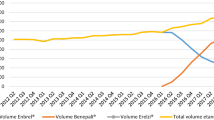Abstract
Objective
This study compared the changes over time in the volume of prescriptions of COX-2 selective inhibitors between rural and urban Queensland to reveal any difference in the uptake of the prescribing of these new drugs between two geographically distinct areas.
Methods
This study used data from an administrative claims database. Dispensing data were obtained for celecoxib and rofecoxib in two areas, one rural and one urban, defined by postcodes. The numbers of consumers in these areas were similar and they were served by similar numbers of general practitioners. The number of defined daily doses (DDDs) of celecoxib and rofecoxib dispensed at specific times was calculated.
Results
Statistical analysis revealed no significant difference between the total numbers of DDDs of COX-2-selective non-steroidal anti-inflammatory drugs dispensed in the rural and urban groups over the period August 2000 to December 2002 (P=0.81). The rate of uptake of usage was also clearly similar between the urban and the rural groups. Total usage peaked in August 2000 in both groups (urban 39 DDD/1,000 people per day; rural 37 DDD/1,000 people per day), coinciding with the pharmaceutical benefits scheme (subsidized) listing of celecoxib. The number of DDDs declined dramatically in the following month, and then peaked again in May 2002 (urban 34, rural 36). The number of DDDs then steadily decreased in both areas after October 2002.
Conclusion
The results suggest that the marketing of the new COX-2 inhibitors and the patients’ anticipation of a safe and effective treatment have overcome the geographical boundaries of Queensland. Both areas had very high rates of uptake of the prescribing of these new drugs.


Similar content being viewed by others
References
Access Economics (2001) The prevalence, cost and disease burden of arthritis in Australia. Prepared for the Arthritis Foundation of Australia, Access Economics, Canberra, March 2001. http://www.accesseconomics.com.au. Cited 5 October 2003
Gomez Cerezo J, Lubomirov Hristov R, Carcas Sansuan AJ, Vazquez Rodriguez JJ (2003) Outcome trials of COX-2 selective inhibitors: global safety evaluation does not promise benefits. Eur J Clin Pharmacol 59(2):169–175
Kerr SJ, Mant A, Horn FE, McGeechan K, Sayer GP (2003) Lessons from early large-scale adoption of celecoxib and rofecoxib by Australian general practitioners. Med J Aust 179(8):403–407
Cutts C, Tett SE (2003) Doctors perceptions of the influences on their prescribing: a comparison of general practitioners based in rural and urban Australia. Eur J Clin Pharmacol 58(11):761–766
Australian Bureau of Statistics: AusStats. http://www.library.uq.edu.au/. Cited 10 February 2003
Health Wiz Version 4.0. National Social Health Statistical Database. Commonwealth Department of Health and Family Services. http://www.library.uq.edu.au./. Cited 10 February 2003
Mant A, Eyland A (1986) General practice location and the use of hypnotics by the elderly. Med J Aust 144:390
Cutts C, Tett SE (2003) Influence on doctor’s prescribing: is geographical remoteness a factor? Aust J Rural Health 11:124–130
Coleman JS, Katz E, Menzel H (1966) Medical innovation—a diffusion study. Bobbs-Merrill, New York
Steffensen FH, Sorensen HT, Olesen F (1999) Diffusion of new drugs in Danish general practice. Fam Prac 16:407–413
Prosser H, Almond S, Walley T (2003) Influences on GPs’ decisions to prescribe new drugs-the importance of who says what. Fam Prac 20:61–68
Jones MI, Greenfield SM, Bradley CP (2001) Prescribing new drugs: qualitative study of influences on consultants and general practitioners. BMJ 323:1–7
Brodie M, Levitt L (2002) Drug advertising: the right or wrong prescription for our ailments? Nat Rev Drug Discov 1(11):916–920
Moynihan R (2003) Who pays for the pizza? Redefining the relationships between doctors and drug companies. 1. Entanglement. BMJ 326:1189–1192
Moynihan R, Bero L, Ross-Degnan D, Henry D, Lee K, Watkins J, Mah C, Soumerai SB (2000) Coverage by the news media of the benefits and risks of medications. New Engl J Med 342(22):1645–1650
Beardon PH, McGilchrist MM, McKendrick AD, McDevitt DG, MacDonald TM (1993) Primary non-compliance with prescribed medication in primary care. BMJ 307(6908):846–848
Author information
Authors and Affiliations
Corresponding author
Additional information
The authors had no financial or other support, or financial or professional relationships that may pose a competing interest.
Rights and permissions
About this article
Cite this article
Behan, K., Cutts, C. & Tett, S.E. Uptake of new drugs in rural and urban areas of Queensland, Australia: the example of COX-2 inhibitors. Eur J Clin Pharmacol 61, 55–58 (2005). https://doi.org/10.1007/s00228-004-0865-6
Received:
Accepted:
Published:
Issue Date:
DOI: https://doi.org/10.1007/s00228-004-0865-6




